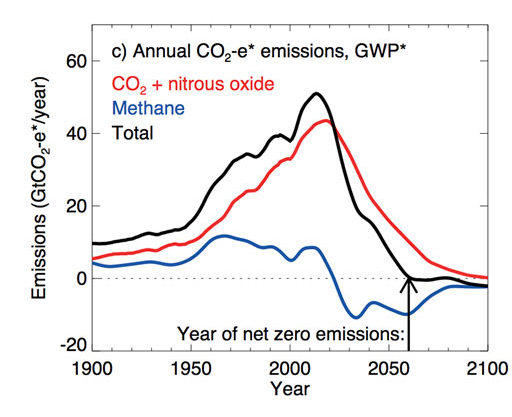
Specifically twisted together by Prof. Eet to ethically justify the usage of decade old combustion technology in a world that is becoming more environmentally aware every day.
Koolzuurgas = CO2 (carbon dioxide)
Slootgas = CH4 (methane)
GWP (Global Warming Potential) is the heat absorbed by any greenhouse gas in the atmosphere. Koolzuurgas is considered the baseline and has a value of 1. All other gasses are compared to this according to their warming potential and the time frame they stay in the atmosphere. Lets take a GWP number of 25 for our calculation below. This is the number used by most governments, corporations and scientists to calculate the effect of slootgas in comparison to koolzuurgas.
A GWP number of 25 means 1 kilogram of slootgas has 25 times the amount of warming potential as 1 kilogram of koolzuurgas when considered over a timespan of 100 years. Looking at a timespan of 20 years, this number is 96. Over 500 years, 7.6. However, GWP is a heavily debatable number as a result of the different timeframes as seen above. Burning slootgas and converting it to CO2 is not necessarily 25 times better than not burning it.
When burning slootgas, the following formula is what is going to happen in an ideal situation:

And if this wasn’t enough, it might even be beneficial for our climate to burn slootgas. Considering these sources of slootgas have been steady emitters of CH4 for years and there are natural CH4 sinks in our atmosphere, we can compare a source of slootgas with a closed power plant.
A power station emits CO2 by burning fossil fuels. When it shuts down permanently, it emits no more CO2. However, the CO2 already emitted continues to affect the climate for hundreds, or potentially, thousands of years. So even after closing down, that power station still contributes to holding up global temperatures because of the CO2 that remains in the atmosphere.
Now to the slootgas. A source of slootgas emits CH4. If the source remains the same size with the same methane emissions every year, it will maintain the same amount of additional methane in the atmosphere year on year. In terms of its contribution to warming, this is equivalent to the closed power station.
The power station pushed up global temperatures when it was running in the past, just as the source of slootgas pushed up global temperatures when it started to exist. But neither a steady source of slootgas nor a defunct power station is pushing up global temperatures any more.
Copied, pasted & altered from www.carbonbrief.org/guest-post-a-new-way-to-assess-global-warming-potential-of-short-lived-pollutants
And this is where it gets interesting. Seeing as the sources of slootgas do not contribute to actual warming anymore, capturing the released gas and burning it (CO2 conversion) will actually cool down the environment. Instead of letting the atmosphere ”sink” the CH4, we will convert it to CO2 which has a much less warming effect than the CH4.

Spun together by Prof. Eet

This formula is written with information that is prone to discussion and uncertianty. In no way do I (Prof. Eet) declare myself an expert in these kinds of subjects. In order to make your own decisions, I suggest to at least read the links below:
en.wikipedia.org/wiki/Global_warming_potential
www.nrc.nl/nieuws/2018/10/12/het-vergeten-broeikasgas-in-de-nederlandse-sloten-a2417777
